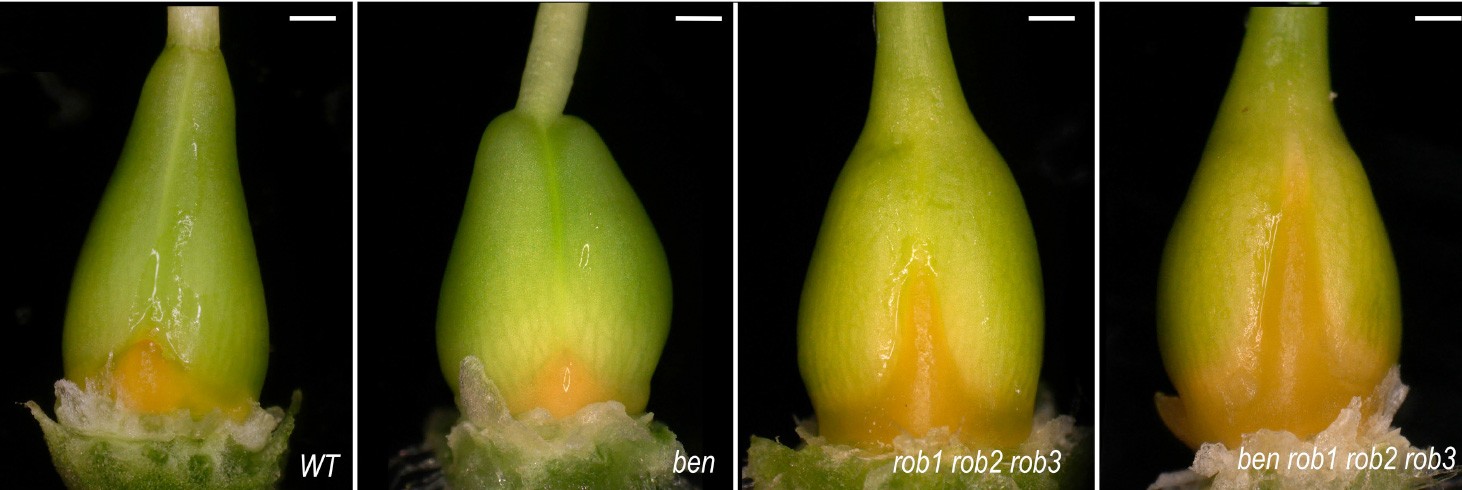博文
Plant Cell:矮牵牛与拟南芥的蜜腺特化(In Brief)
||
Nectary Specification in Petunia and Arabidopsis
First author: Jennifer Mach; Affiliations: The Plant Cell 2958 N Kilbourn Ave: Chicago, USA
Corresponding author: Jennifer Mach
Studies of flower development have lots of information about petals, carpels (心皮), and stamens, but let’s not forget the birds and the bees-and the flies and moths-and what draws pollinators (授粉者) to insect-pollinated flowers, including flower color, shape, and rewards that provide energy. For example, to attract pollinators, many plants produce sugar-rich nectar (花蜜), secreted from specialized organs called nectaries (蜜腺). One tricky (and by tricky, I mean fascinating) aspect of studying nectaries is that different species develop nectaries in different positions relative to the more conserved positions of the other floral organs. Indeed, most angiosperm species develop nectaries near the carpels or stamens, but some develop nectaries on the petiole (叶柄) or at the base of the leaf.
关于植物花的研究多数关注的是花瓣、心皮和雄蕊等方面,还有鸟、蜜粉、苍蝇和飞蛾及吸引昆虫授粉的花部特征,包括花色、形状以及吸引昆虫的能量物质。比如说,有些植物通过产生富含蔗糖的花蜜来吸引授粉者,这些花蜜由植物特异的器官,即蜜腺所分泌。对于花蜜腺组织的研究其中一个令人着迷的地方在于相对于其它位置相对保守的花器官位置,蜜腺在不同植物物种中的位置差别很大。大多数被子植物的蜜腺在心皮或是雄蕊附近,而有些植物的蜜腺在叶柄部位或是叶片基部形成。
p.s. 本文介绍了里昂高等师范学院Michiel Vandenbussche八月份在PLANT CELL上发表的一篇关于开花基因ABC模型中C类基因参与矮牵牛与拟南芥蜜腺特化的文章(The floral C-lineage Genes Trigger Nectary Development in Petunia and Arabidopsis)。
doi: https://doi.org/10.1105/tpc.18.00692
Journal: Plant Cell
First Published: 10 September, 2018
(P.S. 原文下载:链接:https://pan.baidu.com/s/1qFiSsqwlF_7JjmGMbedfhQ 密码:dmu6)
https://blog.sciencenet.cn/blog-3158122-1134303.html
上一篇:Trends in Plant Science:植物光敏色素相互作用因子PIF4
下一篇:New Phytologist:杨树谷胱甘肽S-转移酶蛋白功能分化
全部作者的其他最新博文
- • Plant Physiology:CsMADS3促进柑果中的叶绿素降解和类胡萝卜素合成(华中农业大学)
- • Molecular Plant:LBD11-ROS反馈调节作用于拟南芥的维管形成层增殖和次生生长(浦项科技大学)
- • Science Advances:根结线虫通过调控植物的CLE3-CLV1模块,促进侵染进程(日本熊本大学)
- • Nature Communications:油菜素内酯参与植物营养生长期转变的分子机制解析(浙江农林大学)
- • Current Biology:光合作用产生的蔗糖驱动侧根“生物钟”(德国弗莱堡大学)
- • PNAS:花同源异型基因在叶中被抑制、花中被激活的分子机制(南卡罗来纳大学)

